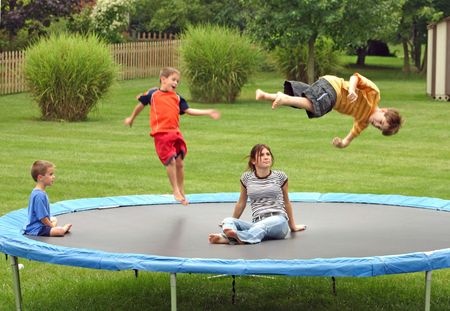

Trampoline Accidents
Despite their popularity, pediatricians and safety experts warn that home trampolines are “intrinsically dangerous” and should be strongly discouraged. Children love to jump on trampolines and parents love that they help their kids burn energy and keep them busy but the risks seem to strongly outweigh the benefits. While trampoline parks are growing in popularity, sales of home trampolines peaked several years ago. A 2007 study conducted by researchers at Brown Medical School reported that despite a decline in sales, trampoline injuries this decade have doubled compared to last decade. They found that over half a million kids were treated in emergency rooms for home trampoline-related injuries between 2000 and 2005.
Parents may believe that they are making their trampoline safe by adding safety features like complete netting enclosures and padding over the springs but according to pediatricians they don’t actually significantly decrease the risk of injury. The American Academy of Orthopedic Surgeons, The Canadian Pediatric Society, and the Canadian Academy of Sports Medicine have all issued similar statements discouraging recreational and playground use of trampolines, citing safety concerns. The American Academy of Pediatrics’ statement on trampoline safety published in the journal Pediatrics does acknowledge that trampolines “…have an acceptable role when used as part of a structured athletic training program with appropriate coaching, supervision, and safety measures in place.”
Trampoline Accidents Statistics
The National Electronic Injury Surveillance report for 2009 estimates that there were 98,000 trampoline-related injuries that year; the injuries resulted in 3,100 hospitalizations. Those numbers are down from 3,300 hospitalizations and 112,000 injuries in 2004.
About 75 percent of trampoline injuries occur when more than one person is jumping on the trampoline.
Kids five and under are usually at greater risk for significant injury in a trampoline accident. Many of these accidents happen under adult supervision.
Although fractures and dislocations make up 48 percent of all trampoline injuries, other common injuries include sprains, strains, and contusions.
Falls from a trampoline caused 27 percent to 39 percent of all injuries; falls can be catastrophic, resulting in head and neck injuries.
Head and neck injuries account for 10 percent to 17 percent of all trampoline accidents.
Common Trampoline Injuries
- Broken arms and legs
- Concussions
- Lacerations
- Abdominal injuries
Trampoline Safety Tips
- One jumper at a time
- No somersaults
- Adult supervision
Many parents simply do not understand the risks associated with jumping on a trampoline nor the liability that comes with allowing other children to jump on your trampoline. Many home insurance policies exclude coverage for trampoline injuries or mandate that they are within enclosed areas with restricted access.
In their defense, trampoline makers say the pediatricians’ statement is based on old data from before safety nets were common and fails to acknowledge the valuable health benefits associated with trampoline use. Today about 85 percent of the approximately 900,000 home trampolines sold are purchased with a safety net. Jumping on a trampoline is a great way to get exercise, which is sorely lacking for too many children in the last decade.
If you or a loved one were injured in an accident, you have enough to deal with. Let an experienced accident attorney fight for the full compensation that you deserve. It is not uncommon to receive a settlement from the insurance company that is five to ten times bigger with the help of a lawyer. Call the caring accident attorneys at Tario & Associates, P.S. in Bellingham, WA today for a FREE consultation! We have been representing residents of Whatcom County, Skagit County, Island County and Snohomish County since 1979. You will pay nothing up front and no attorney fees at all unless we recover damages for you!




